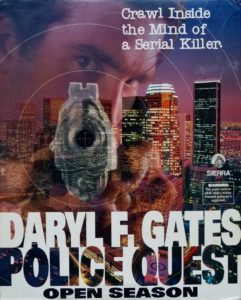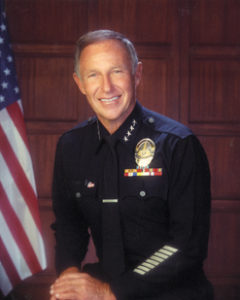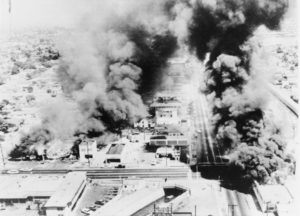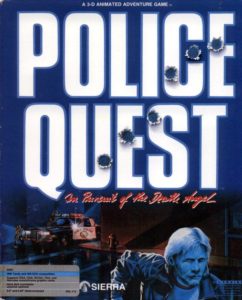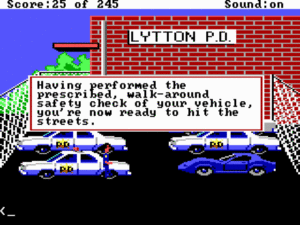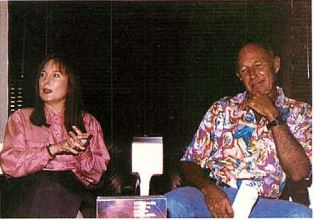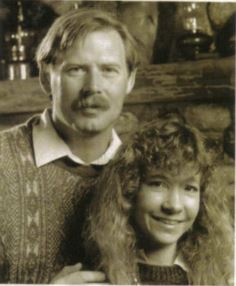One day in late 1992, a trim older man with a rigid military bearing visited Sierra Online’s headquarters in Oakhurst, California. From his appearance, and from the way that Sierra’s head Ken Williams fawned over him, one might have assumed him to be just another wealthy member of the investment class, a group that Williams had been forced to spend a considerable amount of time wooing ever since he had taken his company public four years earlier. But that turned out not to be the case. As Williams began to introduce his guest to some of his employees, he described him as Sierra’s newest game designer, destined to make the fourth game in the Police Quest series. It seemed an unlikely role based on the new arrival’s appearance and age alone.
Yet ageism wasn’t sufficient to explain the effect he had on much of Sierra’s staff. Josh Mandel, a sometime stand-up comic who was now working for Sierra as a writer and designer, wanted nothing whatsoever to do with him: “I wasn’t glad he was there. I just wanted him to go away as soon as possible.” Gano Haine, who was hard at work designing the environmental-themed EcoQuest: Lost Secret of the Rainforest, reluctantly accepted the task of showing the newcomer some of Sierra’s development tools and processes. He listened politely enough, although it wasn’t clear how much he really understood. Then, much to her relief, the boss swept him away again.
The man who had prompted such discomfort and consternation was arguably the most politically polarizing figure in the United States at the time: Daryl F. Gates, the recently resigned head of the Los Angeles Police Department. Eighteen months before, four of his white police officers had brutally beaten a black man — an unarmed small-time lawbreaker named Rodney King — badly enough to break bones and teeth. A private citizen had captured the incident on videotape. One year later, after a true jury of their peers in affluent, white-bread Simi Valley had acquitted the officers despite the damning evidence of the tape, the Los Angeles Riots of 1992 had begun. Americans had watched in disbelief as the worst civil unrest since the infamously restive late 1960s played out on their television screens. The scene looked like a war zone in some less enlightened foreign country; this sort of thing just doesn’t happen here, its viewers had muttered to themselves. But it had happened. The final bill totaled 63 people killed, 2383 people injured, and more than $1 billion in property damage.
The same innocuous visage that was now to become Sierra’s newest game designer had loomed over all of the scenes of violence and destruction. Depending on whether you stood on his side of the cultural divide or the opposite one, the riots were either the living proof that “those people” would only respond to the “hard-nosed” tactics employed by Gates’s LAPD, or the inevitable outcome of decades of those same misguided tactics. The mainstream media hewed more to the latter narrative. When they weren’t showing the riots or the Rodney King tape, they played Gates’s other greatest hits constantly. There was the time he had said, in response to the out-sized numbers of black suspects who died while being apprehended in Los Angeles, that black people were more susceptible to dying in choke holds because their arteries didn’t open as fast as those of “normal people”; the time he had said that anyone who smoked a joint was a traitor against the country and ought to be “taken out and shot”; the time when he had dismissed the idea of employing homosexuals on the force by asking, “Who would want to work with one?”; the time when his officers had broken an innocent man’s nose, and he had responded to the man’s complaint by saying that he was “lucky that was all he had broken”; the time he had called the LAPD’s peers in Philadelphia “an inspiration to the nation” after they had literally launched an airborne bombing raid on a troublesome inner-city housing complex, killing six adults and five children and destroying 61 homes. As the mainstream media was reacting with shock and disgust to all of this and much more, right-wing radio hosts like Rush Limbaugh trotted out the exact same quotes, but greeted them with approbation rather than condemnation.
All of which begs the question of what the hell Gates was doing at Sierra Online, of all places. While they were like most for-profit corporations in avoiding overly overt political statements, Sierra hardly seemed a bastion of reactionary sentiment or what the right wing liked to call “family values.” Just after founding Sierra in 1980, Ken and Roberta Williams had pulled up stakes in Los Angeles and moved to rural Oakhurst more out of some vague hippie dream of getting back to the land than for any sound business reason. As was known by anyone who’d read Steven Levy’s all-too-revealing book Hackers, or seen a topless Roberta on the cover of a game called Softporn, Sierra back in those days had been a nexus of everything the law-and-order contingent despised: casual sex and hard drinking, a fair amount of toking and even the occasional bit of snorting. (Poor Richard Garriott of Ultima fame, who arrived in this den of inequity from a conservative neighborhood of Houston inhabited almost exclusively by straight-arrow astronauts like his dad, ran screaming from it all after just a few months; decades later, he still sounds slightly traumatized when he talks about his sojourn in California.)
It was true that a near-death experience in the mid-1980s and an IPO in 1988 had done much to change life at Sierra since those wild and woolly early days. Ken Williams now wore suits and kept his hair neatly trimmed. He no longer slammed down shots of tequila with his employees to celebrate the close of business on a Friday, nor made it his personal mission to get his nerdier charges laid; nor did he and Roberta still host bathing-suit-optional hot-tub parties at their house. But when it came to the important questions, Williams’s social politics still seemed diametrically opposed to the likes to Daryl Gates. For example, at a time when even the mainstream media still tended to dismiss concerns about the environment as obsessions of the Loony Left, he’d enthusiastically approved Gano Haines’s idea for a series of educational adventure games to teach children about just those issues. When a 15-year-old who already had the world all figured out wrote in to ask how Sierra could “give in to the doom-and-gloomers and whacko commie liberal environmentalists” who believed that “we can destroy a huge, God-created world like this,” Ken’s brother John Williams — Sierra’s marketing head — offered an unapologetic and cogent response: “As long as we get letters like this, we’ll keep making games like EcoQuest.”
So, what gave? Really, what was Daryl Gates doing here? And how had this figure that some of Ken Williams’s employees could barely stand to look at become connected with Police Quest, a slightly goofy and very erratic series of games, but basically a harmless one prior to this point? To understand how all of these trajectories came to meet that day in Oakhurst, we need to trace each back to its point of origin.
Perhaps the kindest thing we can say about Daryl Gates is that he was, like the young black men he and his officers killed, beat, and imprisoned by the thousands, a product of his environment. He was, the sufficiently committed apologist might say, merely a product of the institutional culture in which he was immersed throughout his adult life. Seen in this light, his greatest sin was his inability to rise above his circumstances, a failing which hardly sets him apart from the masses. One can only wish he had been able to extend to the aforementioned black men the same benefit of the doubt which other charitable souls might be willing to give to him.
Long before he himself became the head of the LAPD, Gates was the hand-picked protege of William Parker, the man who has gone down in history as the architect of the legacy Gates would eventually inherit. At the time Parker took control of it in 1950, the LAPD was widely regarded as the most corrupt single police force in the country, its officers for sale to absolutely anyone who could pay their price; they went so far as to shake down ordinary motorists for bribes at simple traffic stops. To his credit, Parker put a stop to all that. But to his great demerit, he replaced rank corruption on the individual level with an us-against-them form of esprit de corps — the “them” here being the people of color who were pouring into Los Angeles in ever greater numbers. Much of Parker’s approach was seemingly born of his experience of combat during World War II. He became the first but by no means the last LAPD chief to make comparisons between his police force and an army at war, without ever considering whether the metaphor was really appropriate.
Parker was such a cold fish that Star Trek creator Gene Roddenberry, who served as an LAPD officer during his tenure as chief, would later claim to have modeled the personality of the emotionless alien Spock on him. And yet, living as he did in the epicenter of the entertainment industry — albeit mostly patrolling the parts of Los Angeles that were never shown by Hollywood — Parker was surprisingly adept at manipulating the media to his advantage. Indeed, he became one of those hidden players who sometimes shape media narratives without anyone ever quite realizing that they’re doing so. He served as a consultant for the television show Dragnet, and through it created a pernicious cliché of the “ideal” cop that can still be seen, more than half a century later, on American television screens every evening: the cop as tough crusader who has to knock a few heads sometimes and bend or break the rules to get around the pansy lawyers, but who does it all for a noble cause, guided by an infallible moral compass that demands that he protect the “good people” of his city from the irredeemably bad ones by whatever means are necessary. Certainly Daryl Gates would later benefit greatly from this image; it’s not hard to believe that even Ken Williams, who fancied himself something of a savvy tough guy in his own right, was a little in awe of it when he tapped Gates to make a computer game.
But this wasn’t the only one of Chief Parker’s innovations that would come to the service of the man he liked to describe as the son he’d never had. Taking advantage of a city government desperate to see a cleaned-up LAPD, Parker drove home policies that made the city’s police force a veritable fiefdom unto itself, its chief effectively impossible to fire. The city council could only do so “for cause” — i.e., some explicit failure on the chief’s part. This sounded fair enough — until one realized that the chief got to write his own evaluation every year. Naturally, Parker and his successors got an “excellent” score every time, and thus the LAPD remained for decades virtually impervious to the wishes of the politicians and public it allegedly served.
As Parker’s tenure wore on, tension spiraled in the black areas of Los Angeles, the inevitable response to an utterly unaccountable LAPD’s ever more brutal approach to policing. It finally erupted in August of 1965 in the form of the Watts Riots, the great prelude to the riots of 1992: 34 deaths, $40 million in property damage in contemporary dollars. For Daryl Gates, who watched it all take place by Parker’s side, the Watts Riots became a formative crucible. “We had no idea how to deal with this,” he would later write. “We were constantly ducking bottles, rocks, knives, and Molotov cocktails. It was random chaos. We did not know how to handle guerrilla warfare.” Rather than asking himself how it had come to this in the first place and how such chaos might be prevented in the future, he asked how the LAPD could be prepared to go toe to toe with future rioters in what amounted to open warfare on city streets.
Chief Parker died the following year, but Gates’s star remained on the ascendant even without his patron. He came up with the idea of a hardcore elite force for dealing with full-on-combat situations, a sort of SEAL team of police. Of course, the new force would need an acronym that sounded every bit as cool as its Navy inspiration. He proposed SWAT, for “Special Weapons Attack Teams.” When his boss balked at such overtly militaristic language, he said that it could stand for “Special Weapons and Tactics” instead. “That’s fine,” said his boss.
Gates and his SWAT team had their national coming-out party on December 6, 1969, when they launched an unprovoked attack upon a hideout of the Black Panthers, a well-armed militia composed of black nationalists which had been formed as a response to earlier police brutality. Logistically and practically, the raid was a bit of a fiasco. The attackers got discombobulated by an inaccurate map of the building and very nearly got themselves hemmed into a cul de sac and massacred. (“Oh, God, we were lucky,” said one of them later.) What was supposed to have been a blitzkrieg-style raid devolved into a long stalemate. The standoff was broken only when Gates managed to requisition a grenade launcher from the Marines at nearby Camp Pendleton and started lobbing explosives into the building; this finally prompted the Panthers to surrender. By some miracle, no one on either side got killed, but the Panthers were acquitted in court of most charges on the basis of self-defense.
Yet the practical ineffectuality of the operation mattered not at all to the political narrative that came to be attached to it. The conservative white Americans whom President Nixon loved to call “the silent majority” — recoiling from the sex, drugs, and rock and roll of the hippie era, genuinely scared by the street violence of the last several years — applauded Gates’s determination to “get tough” with “those people.” For the first time, the names of Daryl Gates and his brainchild of SWAT entered the public discourse beyond Los Angeles.
In May of 1974, the same names made the news in a big way again when a SWAT team was called in to subdue the Symbionese Liberation Army, a radical militia with a virtually incomprehensible political philosophy, who had recently kidnapped and apparently converted to their cause the wealthy heiress Patty Hearst. After much lobbying on Gate’s part, his SWAT team got the green light to mount a full frontal assault on the group’s hideout. Gates and his officers continued to relish military comparisons. “Here in the heart of Los Angeles was a war zone,” he later wrote. “It was like something out of a World War II movie, where you’re taking the city from the enemy, house by house.” More than 9000 rounds of ammunition were fired by the two sides. But by now, the SWAT officers did appear to be getting better at their craft. Eight members of the militia were killed — albeit two of them unarmed women attempting to surrender — and the police officers received nary a scratch. Hearst herself proved not to be inside the hideout, but was arrested shortly after the battle.
The Patti Hearst saga marked the last gasp of a militant left wing in the United States; the hippies of the 1960s were settling down to become the Me Generation of the 1970s. Yet even as the streets were growing less turbulent, increasingly militaristic rhetoric was being applied to what had heretofore been thought of as civil society. In 1971, Nixon had declared a “war on drugs,” thus changing the tone of the discourse around policing and criminal justice markedly. Gates and SWAT were the perfect mascots for the new era. The year after the Symbionese shootout, ABC debuted a hit television series called simply S.W.A.T. Its theme song topped the charts; there were S.W.A.T. lunch boxes, action figures, board games, and jigsaw puzzles. Everyone, it seemed, wanted to be like Daryl Gates and the LAPD — not least their fellow police officers in other cities: by July of 1975, there were 500 other SWAT teams in the United States. Gates embraced his new role of “America’s cop” with enthusiasm.
In light of his celebrity status in a city which worships celebrity, it was now inevitable that Gates would become the head of the LAPD just as soon as the post opened up. He took over in 1978; this gave him an even more powerful nationwide bully pulpit. In 1983, he applied some of his clout to the founding of a program called DARE in partnership with public schools around the country. The name stood for “Drug Abuse Resistance Education”; Gates really did have a knack for snappy acronyms. His heart was perhaps in the right place, but later studies, conducted only after the spending of hundreds of millions in taxpayer dollars, would prove the program’s strident rhetoric and almost militaristic indoctrination techniques to be ineffective.
Meanwhile, in his day job as chief of police, Gates fostered an ever more toxic culture that viewed the streets as battlegrounds, that viewed an ass beating as the just reward of any black man who failed to treat a police officer with fawning subservience. In 1984, the Summer Olympics came to Los Angeles, and Gates used the occasion to convince the city council to let him buy armored personnel carriers — veritable tanks for the city streets — in the interest of “crowd control.” When the Olympics were over, he held onto them for the purpose of executing “no-knock” search warrants on suspected drug dens. During the first of these, conducted with great fanfare before an invited press in February of 1985, Gates himself rode along as an APC literally drove through the front door of a house after giving the occupants no warning whatsoever. Inside they found two shocked women and three children, with no substance more illicit than the bowls of ice cream they’d been eating. To top it all off, the driver lost control of the vehicle on a patch of ice whilst everyone was sheepishly leaving the scene, taking out a parked car.
Clearly Gates’s competence still tended not to entirely live up to his rhetoric, a discrepancy the Los Angeles Riots would eventually highlight all too plainly. But in the meantime, Gates was unapologetic about the spirit behind the raid: “It frightened even the hardcore pushers to imagine that at any moment a device was going to put a big hole in their place of business, and in would march SWAT, scattering flash-bangs and scaring the hell out of everyone.” This scene would indeed be played out many times over the remaining years of Gates’s chiefdom. But then along came Rodney King of all people to take the inadvertent role of his bête noire.
King was a rather-slow-witted janitor and sometime petty criminal with a bumbling reputation on the street. He’d recently done a year in prison after attempting to rob a convenience store with a tire iron; over the course of the crime, the owner of the store had somehow wound up disarming him, beating him over the head with his own weapon, and chasing him off the premises. He was still on parole for that conviction on the evening of March 3, 1991, when he was spotted by two LAPD officers speeding down the freeway. King had been drinking, and so, seeing their patrol car’s flashing lights in his rear-view mirror, he decided to make a run for it. He led what turned into a whole caravan of police cars on a merry chase until he found himself hopelessly hemmed in on a side street. The unarmed man then climbed out of his car and lay face down on the ground, as instructed. But then he stood up and tried to make a break for it on foot, despite being completely surrounded. Four of the 31 officers on the scene now proceeded to knock him down and beat him badly enough with their batons and boots to fracture his face and break one of his ankles. Their colleagues simply stood and watched at a distance.
Had not a plumber named George Holliday owned an apartment looking down on that section of street, the incident would doubtless have gone down in the LAPD’s logs as just another example of a black man “resisting arrest” and getting regrettably injured in the process. But Holliday was there, standing on his balcony — and he had a camcorder to record it all. When he sent his videotape to a local television station, its images of the officers taking big two-handed swings against King’s helpless body with their batons ignited a national firestorm. The local prosecutor had little choice but to bring the four officers up on charges.
The tactics of Daryl Gates now came under widespread negative scrutiny for the first time. Although he claimed to support the prosecution of the officers involved, he was nevertheless blamed for fostering the culture that had led to this incident, as well as the many others like it that had gone un-filmed. At long last, reporters started asking the black residents of Los Angeles directly about their experiences with the LAPD. A typical LAPD arrest, said one of them, “basically consisted of three or four cops handcuffing a person, and just literally beating him, often until unconscious… punching, beating, kicking.” A hastily assembled city commission produced pages and pages of descriptions of a police force run amok. “It is apparent,” the final report read, “that too many LAPD patrol officers view citizens with resentment and hostility.” In response, Gates promised to retire “soon.” Yet, as month after month went by and he showed no sign of fulfilling his promise, many began to suspect that he still had hopes of weathering the storm.
At any rate, he was still there on April 29, 1992. That was the day his four cops were acquitted in Simi Valley, a place LAPD officers referred to as “cop heaven”; huge numbers of them lived there. Within two hours after the verdict was announced, the Los Angeles Riots began in apocalyptic fashion, as a mob of black men pulled a white truck driver out of his cab and all but tore him limb from limb in the process of murdering him, all under the watchful eye of a helicopter that was hovering overhead and filming the carnage.
Tellingly, Gates happened to be speaking to an adoring audience of white patrons in the wealthy suburb of Brentwood at the very instant the riots began. As the violence continued, this foremost advocate of militaristic policing seemed bizarrely paralyzed. South Los Angeles burned, and the LAPD did virtually nothing about it. The most charitable explanation had it that Gates, spooked by the press coverage of the previous year, was terrified of how white police officers subduing black rioters would play on television. A less charitable one, hewed to by many black and liberal commentators, had it that Gates had decided that these parts of the city just weren’t worth saving — had decided to just let the rioters have their fun and burn it all down. But the problem, of course, was that in the meantime many innocent people of all colors were being killed and wounded and seeing their property go up in smoke. Finally, the mayor called in the National Guard to quell the rioting while Gates continued to sit on his hands.
Asked afterward how the LAPD — the very birthplace of SWAT — had allowed things to get so out of hand, Gates blamed it on a subordinate: “We had a lieutenant down there who just didn’t seem to know what to do, and he let us down.” Not only was this absurd, but it was hard to label as anything other than moral cowardice. It was especially rich coming from a man who had always preached an esprit de corps based on loyalty and honor. The situation was now truly untenable for him. Incompetence, cowardice, racism, brutality… whichever charge or charges you chose to apply, the man had to go. Gates resigned, for real this time, on June 28, 1992.
Yet he didn’t go away quietly. Gates appears to have modeled his post-public-service media strategy to a large extent on that of Oliver North, a locus of controversy for his role in President Ronald Reagan’s Iron-Contra scandal who had parlayed his dubious celebrity into the role of hero to the American right. Gates too gave a series of angry, unrepentant interviews, touted a recently published autobiography, and even went North one better when he won his own radio show which played in close proximity to that of Rush Limbaugh. And then, when Ken Williams came knocking, he welcomed that attention as well.
But why would Williams choose to cast his lot with such a controversial figure, one whose background and bearing were so different from his own? To begin to understand that, we need to look back to the origins of the adventure-game oddity known as Police Quest.
Ken Williams, it would seem, had always had a fascination with the boys in blue. One day in 1985, when he learned from his hairdresser that her husband was a California Highway Patrol officer on administrative leave for post-traumatic stress, his interest was piqued. He invited the cop in question, one Jim Walls, over to his house to play some racquetball and drink some beer. Before the evening was over, he had starting asking his guest whether he’d be interested in designing a game for Sierra. Walls had barely ever used a computer, and had certainly never played an adventure game on one, so he had only the vaguest idea what his new drinking buddy was talking about. But the only alternative, as he would later put it, was to “sit around and think” about the recent shootout that had nearly gotten him killed, so he agreed to give it a go.
The game which finally emerged from that conversation more than two years later shows the best and the worst of Sierra. On the one hand, it pushed a medium that was usually content to wallow in the same few fictional genres in a genuinely new direction. In a pair of articles he wrote for Computer Gaming World magazine, John Williams positioned Police Quest: In Pursuit of the Death Angel at the forefront of a new wave of “adult” software able to appeal to a whole new audience, noting how it evoked Joseph Wambaugh rather than J.R.R. Tolkien, Hill Street Blues rather than Star Wars. Conceptually, it was indeed a welcome antidote to a bad case of tunnel vision afflicting the entire computer-games industry.
In practical terms, however, it was somewhat less inspiring. The continual sin of Ken Williams and Sierra throughout the company’s existence was their failure to provide welcome fresh voices like that of Jim Walls with the support network that might have allowed them to make good games out of their well of experiences. Left to fend for himself, Walls, being the law-and-order kind of guy he was, devised the most pedantic adventure game of all time, one which played like an interactive adaptation of a police-academy procedure manual — so much so, in fact, that a number of police academies around the country would soon claim to be employing it as a training tool. The approach is simplicity itself: in every situation, if you do exactly what the rules of police procedure that are exhaustively described in the game’s documentation tell you to do, you get to live and go on to the next scene. If you don’t, you die. It may have worked as an adjunct to a police-academy course, but it’s less compelling as a piece of pure entertainment.
Although it’s an atypical Sierra adventure game in many respects, this first Police Quest nonetheless opens with what I’ve always considered to be the most indelibly Sierra moment of all. The manual has carefully explained — you did read it, right? — that you must walk all the way around your patrol car to check the tires and lights and so forth every time you’re about to drive somewhere. And sure enough, if you fail to do so before you get into your car for the first time, a tire blows out and you die as soon as you drive away. But if you do examine your vehicle, you find no evidence of a damaged tire, and you never have to deal with any blow-out once you start driving. The mask has fallen away to reveal what we always suspected: that the game actively wants to kill you, and is scheming constantly for a way to do so. There’s not even any pretension left of fidelity to a simulated world — just pure, naked malice. Robb Sherwin once memorably said that “Zork hates its player.” Well, Zork‘s got nothing on Police Quest.
Nevertheless, Police Quest struck a modest chord with Sierra’s fan base. While it didn’t become as big a hit as Leisure Suit Larry in the Land of the Lounge Lizards, John Williams’s other touted 1987 embodiment of a new wave of “adult” games, it sold well enough to mark the starting point of another of the long series that were the foundation of Sierra’s marketing strategy. Jim Walls designed two sequels over the next four years, improving at least somewhat at his craft in the process. (In between them, he also came up with Code-Name: Iceman, a rather confused attempt at a Tom Clancy-style techno-thriller that was a bridge too far even for most of Sierra’s loyal fans.)
But shortly after completing Police Quest 3: The Kindred, Walls left Sierra along with a number of other employees to join Tsunami Media, a new company formed right there in Oakhurst by Edmond Heinbockel, himself a former chief financial officer for Sierra. With Walls gone, but his Police Quest franchise still selling well enough to make another entry financially viable, the door was wide open — as Ken Williams saw it, anyway — for one Daryl F. Gates.
Williams began his courtship of the most controversial man in the United States by the old-fashioned expedient of writing him a letter. Gates, who claimed never even to have used a computer, much less played a game on one, was initially confused about what exactly Williams wanted from him. Presuming Williams was just one of his admirers, he sent a letter back asking for some free games for some youngsters who lived across the street from him. Williams obliged in calculated fashion, with the three extant Police Quest games. From that initial overture, he progressed to buttering Gates up over the telephone.
As the relationship moved toward the payoff stage, some of his employees tried desperately to dissuade him from getting Sierra into bed with such a figure. “I thought it’s one thing to seek controversy, but another thing to really divide people,” remembers Josh Mandel. Mandel showed his boss a New York Times article about Gates’s checkered history, only to be told that “our players don’t read the New York Times.” He suggested that Sierra court Joseph Wambaugh instead, another former LAPD officer whose novels presented a relatively more nuanced picture of crime and punishment in the City of Angels than did Gates’s incendiary rhetoric; Wambaugh was even a name whom John Williams had explicitly mentioned in the context of the first Police Quest game five years before. But that line of attack was also hopeless; Ken Williams wanted a true mass-media celebrity, not a mere author who hid behind his books. So, Gates made his uncomfortable visit to Oakhurst and the contract was signed. Police Quest would henceforward be known as Daryl F. Gates’ Police Quest. Naturally, the setting of the series would now become Los Angeles; the fictional town of Lytton, the more bucolic setting of the previous three games in the series, was to be abandoned along with almost everything else previously established by Jim Walls.
Inside the company, a stubborn core of dissenters took to calling the game Rodney King’s Quest. Corey Cole, co-designer of the Quest for Glory series, remembers himself and many others being “horrified” at the prospect of even working in the vicinity of Gates: “As far as we were concerned, his name was mud and tainted everything it touched.” As a designer, Corey felt most of all for Jim Walls. He believed Ken Williams was “robbing Walls of his creation”: “It would be like putting Donald Trump’s name on a new Quest for Glory in today’s terms.”
Nevertheless, as the boss’s pet project, Gates’s game went inexorably forward. It was to be given the full multimedia treatment, including voice acting and the extensive use of digitized scenes and actors on the screen in the place of hand-drawn graphics. Indeed, this would become the first Sierra game that could be called a full-blown full-motion-video adventure, placing it at the vanguard of the industry’s hottest new trend.
Of course, there had never been any real expectation that Gates would roll up his sleeves and design a computer game in the way that Jim Walls had; celebrity did have its privileges, after all. Daryl F. Gates’ Police Quest: Open Season thus wound up in the hands of Tammy Dargan, a Sierra producer who, based on an earlier job she’d had with the tabloid television show America’s Most Wanted, now got the chance to try her hand at design. Corey Cole ironically remembers her as one of the most stereotypically liberal of all Sierra’s employees: “She strenuously objected to the use of [the word] ‘native’ in Quest for Glory III, and globally changed it to ‘indigenous.’ We thought that ‘the indigenous flora’ was a rather awkward construction, so we changed some of those back. But she was also a professional and did the jobs assigned to her.”
In this case, doing so would entail writing the script for a game about the mean streets of Los Angeles essentially alone, then sending it to Gates via post for “suggestions.” The latter did become at least somewhat more engaged when the time came for “filming,” using his connections to get Sierra inside the LAPD’s headquarters and even into a popular “cop bar.” Gates himself also made it into the game proper: restored to his rightful status of chief of police, he looks on approvingly and proffers occasional bits of advice as you work through the case. The CD-ROM version tacked on some DARE propaganda and a video interview with Gates, giving him yet one more opportunity to respond to his critics.
Contrary to the expectations raised both by the previous games in the series and the reputation of Gates, the player doesn’t take the role of a uniformed cop at all, but rather that of a plain-clothes detective. Otherwise, though, the game is both predictable in theme and predictably dire. Really, what more could one expect from a first-time designer working in a culture that placed no particular priority on good design, making a game that no one there particularly wanted to be making?
So, the dialog rides its banality to new depths for a series already known for clunky writing, the voice acting is awful — apparently the budget didn’t stretch far enough to allow the sorts of good voice actors that had made such a difference in King’s Quest VI — and the puzzle design is nonsensical. The plot, which revolves around a series of brutal cop killings for maximum sensationalism, wobbles along on rails through its ever more gruesome crime scenes and red-herring suspects until the real killer suddenly appears out of the blue in response to pretty much nothing which you’ve done up to that point. And the worldview the whole thing reflects… oh, my. The previous Police Quest games had hardly been notable for their sociological subtlety — “These kinds of people are actually running around out there, even if we don’t want to think about it,” Jim Walls had said of its antagonists — but this fourth game takes its demonization of all that isn’t white, straight, and suburban to what would be a comical extreme if it wasn’t so hateful. A brutal street gang, the in-game police files helpfully tell us, is made up of “unwed mothers on public assistance,” and the cop killer turns out to be a transvestite; his “deviancy” constitutes the sum total of his motivation for killing, at least as far as we ever learn.
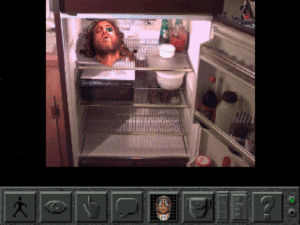
One of the grisly scenes with which Open Season is peppered, reflecting a black-and-white — in more ways than one! — worldview where the irredeemably bad, deviant people are always out to get the good, normal people. Lucky we have the likes of Daryl Gates to sort the one from the other, eh?
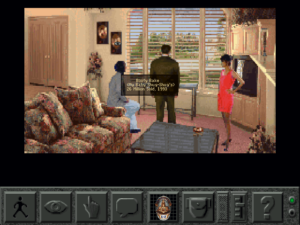
Visiting a rap record label, one of a number of places where Sierra’s pasty-white writers get to try out their urban lingo. It goes about as well as you might expect.
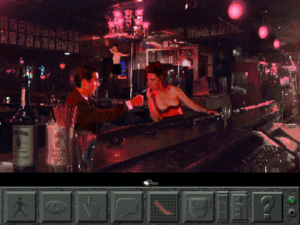
Sierra throws in a strip bar for the sake of gritty realism. Why is it that television (and now computer-game) cops always have to visit these places — strictly in order to pursue leads, of course.
But the actual game of Open Season is almost as irrelevant to any discussion of the project’s historical importance today as it was to Ken Williams at the time. This was a marketing exercise, pure and simple. Thus Daryl Gates spent much more time promoting the game than he ever had making it. Williams put on the full-court press in terms of promotion, publishing not one, not two, but three feature interviews with him in Sierra’s news magazine and booking further interviews with whoever would talk to him. The exchanges with scribes from the computing press, who had no training or motivation for asking tough questions, went about as predictably as the game’s plot. Gates dismissed the outrage over the Rodney King tape as “Monday morning quarterbacking,” and consciously or unconsciously evoked Richard Nixon’s silent majority in noting that the “good, ordinary, responsible, quiet citizens” — the same ones who saw the need to get tough on crime and prosecute a war on drugs — would undoubtedly enjoy the game. Meanwhile Sierra’s competitors weren’t quite sure what to make of it all. “Talk about hot properties,” wrote the editors of Origin Systems’s internal newsletter, seemingly uncertain whether to express anger or admiration for Sierra’s sheer chutzpah. “No confirmation yet as to whether the game will ship with its own special solid-steel joystick” — a dark reference to the batons with which Gates’s officers had beat Rodney King.
In the end, though, the game generated decidedly less controversy than Ken Williams had hoped for. The computer-gaming press just wasn’t politically engaged enough to do much more than shrug their shoulders at its implications. And by the time it was released it was November of 1993, and Gates was already becoming old news for the mainstream press as well. The president of the Los Angeles Urban League did provide an obligingly outraged quote, saying that Gates “embodies all that is bad in law enforcement—the problems of the macho, racist, brutal police experience that we’re working hard to put behind us. That anyone would hire him for a project like this proves that some companies will do anything for the almighty dollar.” But that was about as good as it got.
There’s certainly no reason to believe that Gates’s game sold any better than the run-of-the-mill Sierra adventure, or than any of the Police Quest games that had preceded it. If anything, the presence of Gates’s name on the box seems to have put off more fans than it attracted. Rather than a new beginning, Open Season proved the end of the line for Police Quest as an adventure series — albeit not for Sierra’s involvement with Gates himself. The product line was retooled in 1995 into Daryl F. Gates’ Police Quest: SWAT, a “tactical simulator” of police work that played suspiciously like any number of outright war simulators. In this form, it found a more receptive audience and continued for years. Tammy Dargan remained at the reinvented series’s head for much of its run. History hasn’t recorded whether her bleeding-heart liberal sympathies went into abeyance after her time with Gates or whether the series remained just a slightly distasteful job she had to do.
Gates, on the other hand, got dropped after the first SWAT game. His radio show had been cancelled after he had proved himself to be a stodgy bore on the air, without even the modicum of wit that marked the likes of a Rush Limbaugh. Having thus failed in his new career as a media provocateur, and deprived forevermore of his old position of authority, his time as a political lightning rod had just about run out. What then was the use of Sierra continuing to pay him?
But then, Daryl Gates was never the most interesting person behind the games that bore his name. The hard-bitten old reactionary was always a predictable, easily known quantity, and therefore one with no real power to fascinate. Much more interesting was and is Ken Williams, this huge, mercurial personality who never designed a game himself but who lurked as an almost palpable presence in the background of every game Sierra ever released as an independent company. In short, Sierra was his baby, destined from the first to become his legacy more so than that of any member of his creative staff.
Said legacy is, like the man himself, a maze of contradictions resistant to easy judgments. Everything you can say about Ken Williams and Sierra, whether positive or negative, seems to come equipped with a “but” that points in the opposite direction. So, we can laud him for having the vision to say something like this, which accurately diagnosed the problem of an industry offering a nearly exclusive diet of games by and for young white men obsessed with Star Wars and The Lord of the Rings:
If you match the top-selling books, records, or films to the top-selling computer-entertainment titles, you’ll immediately notice differences. Where are the romance, horror, and non-fiction titles? Where’s military fiction? Where’s all the insider political stories? Music in computer games is infinitely better than what we had a few years back, but it doesn’t match what people are buying today. Where’s the country-western music? The rap? The reggae? The new age?
And yet Williams approached his self-assigned mission of broadening the market for computer games with a disconcerting mixture of crassness and sheer naivete. The former seemed somehow endemic to the man, no matter how hard he worked to conceal it behind high-flown rhetoric, while the latter signified a man who appeared never to have seriously thought about the nature of mass media before he started trying to make it for himself. “For a publisher to not publish a product which many customers want to buy is censorship,” he said at one point. No, it’s not, actually; it’s called curation, and is the right and perhaps the duty of every content publisher — not that there were lines of customers begging Sierra for a Daryl Gates-helmed Police Quest game anyway. With that game, Williams became, whatever else he was, a shameless wannabe exploiter of a bleeding wound at the heart of his nation — and he wasn’t even very good at it, as shown by the tepid reaction to his “controversial” game. His decision to make it reflects not just a moral failure but an intellectual misunderstanding of his audience so extreme as to border on the bizarre. Has anyone ever bought an adventure game strictly because it’s controversial?
So, if there’s a pattern to the history of Ken Williams and Sierra — and the two really are all but inseparable — it’s one of talking a good game, of being broadly right with the vision thing, but falling down in the details and execution. Another example from the horse’s mouth, describing the broad idea that supposedly led to Open Season:
The reason that I’m working with Chief Gates is that one of my goals has been to create a series of adventure games which accomplish reality through having been written by real experts. I have been calling this series of games the “Reality Role-Playing” series. I want to find the top cop, lawyer, airline pilot, fireman, race-car driver, politician, military hero, schoolteacher, white-water rafter, mountain climber, etc., and have them work with us on a simulation of their world. Chief Gates gives us the cop game. We are working with Emerson Fittipaldi to simulate racing, and expect to announce soon that Vincent Bugliosi, the lawyer who locked up Charles Manson, will be working with us to do a courtroom simulation. My goal is that products in the Reality Role-Playing series will be viewed as serious simulations of real-world events, not as games. If we do our jobs right, this will be the closest most of us will ever get to seeing the world through these people’s eyes.
The idea sounds magnificent, so much so that one can’t help but feel a twinge of regret that it never went any further than Open Season. Games excel at immersion, and their ability to let us walk a mile in someone else’s shoes — to become someone whose world we would otherwise never know — is still sadly underutilized.
I often — perhaps too often — use Sierra’s arch-rivals in adventure games LucasArts as my own baton with which to beat them, pointing out how much more thoughtful and polished the latter’s designs were. This remains true enough. Yet it’s also true that LucasArts had nothing like the ambition for adventure games which Ken Williams expresses here. LucasArts found what worked for them very early on — that thing being cartoon comedies — and rode that same horse relentlessly right up until the market for adventures in general went away. Tellingly, when they were asked to adapt Indiana Jones to an interactive medium, they responded not so much by adjusting their standard approach all that radically as by turning Indy himself into a cartoon character. Something tells me that Ken Williams would have taken a very different tack.
But then we get to the implementation of Williams’s ideas by Sierra in the form of Open Season, and the questions begin all over again. Was Daryl Gates truly, as one of the marketers’ puff pieces claimed, “the most knowledgeable authority on law enforcement alive?” Or was there some other motivation involved? I trust the answer is self-evident. (John Williams even admitted as much in another of the puff pieces: “[Ken] decided the whole controversy over Gates would ultimately help the game sell better.”) And then, why does the “reality role-playing” series have to focus only on those with prestige and power? If Williams truly does just want to share the lives of others with us and give us a shared basis for empathy and discussion, why not make a game about what it’s like to be a Rodney King?
Was it because Ken Williams was himself a racist and a bigot? That’s a major charge to level, and one that’s neither helpful nor warranted here — no, not even though he championed a distinctly racist and bigoted game, released under the banner of a thoroughly unpleasant man who had long made dog whistles to racism and bigotry his calling card. Despite all that, the story of Open Season‘s creation is more one of thoughtlessness than malice aforethought. It literally never occurred to Ken Williams that anyone living in South Los Angeles would ever think of buying a Sierra game; that territory was more foreign to him than that of Europe (where Sierra was in fact making an aggressive play at the time). Thus he felt free to exploit a community’s trauma with this distasteful product and this disingenuous narrative that it was created to engender “discussion.” For nothing actually to be found within Open Season is remotely conducive to civil discussion.
Williams stated just as he was beginning his courtship of Daryl Gates that, in a fast-moving industry, he had to choose whether to “lead, follow, or get out of the way. I don’t believe in following, and I’m not about to get out of the way. Therefore, if I am to lead then I have to know where I’m going.” And here we come to the big-picture thing again, the thing at which Williams tended to excel. His decision to work with Gates does indeed stand as a harbinger of where much of gaming was going. This time, though, it’s a sad harbinger rather than a happy one.
I believe that the last several centuries — and certainly the last several decades — have seen us all slowly learning to be kinder and more respectful to one another. It hasn’t been a linear progression by any means, and we still have one hell of a long way to go, but it’s hard to deny that it’s occurred. (Whatever the disappointments of the last several years, the fact remains that the United States elected a black man as president in 2008, and has finally accepted the right of gay people to marry even more recently. Both of these things were unthinkable in 1993.) In some cases, gaming has reflected this progress. But too often, large segments of gaming culture have chosen to side instead with the reactionaries and the bigots, as Sierra implicitly did here.
So, Ken Williams and Sierra somehow managed to encompass both the best and the worst of what seems destined to go down in history as the defining art form of the 21st century, and they did so long before that century began. Yes, that’s quite an achievement in its own right — but, as Open Season so painfully reminds us, not an unmixed one.
(Sources: the books Blue: The LAPD and the Battle to Redeem American Policing by Joe Domanick and Rise of the Warrior Cop: The Militarization of America’s Police Forces by Radley Balko; Computer Gaming World of August/September 1987, October 1987, and December 1993; Sierra’s news magazines of Summer 1991, Winter 1992, June 1993, Summer 1993, Holiday 1993, and Spring 1994; Electronic Games of October 1993; Origin Systems’s internal newsletter Point of Origin of February 26 1993. Online sources include an excellent and invaluable Vice article on Open Season and the information about the Rodney King beating and subsequent trial found on Famous American Trials. And my thanks go out yet again to Corey Cole, who took the time to answer some questions about this period of Sierra’s history from his perspective as a developer there.
The four Police Quest adventure games are available for digital purchase at GOG.com.)
Original URL: https://www.filfre.net/2019/07/chief-gates-comes-to-oakhurst-a-cop-drama/

